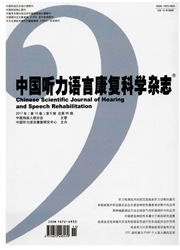

 中文摘要:
中文摘要:
目的: SLC26A4基因突变已被证实与前庭导水管扩大及其相关的内耳发育畸形密切相关。本研究对12例不合并前庭导水管扩大的内耳畸形耳聋患者进行基因筛查,以明确其可能的致病相关基因。方法所有患者均通过颞骨CT及内听道MRI明确其内耳发育畸形特征。知情同意后采集患者外周血基因组DNA,对SLC26A4基因、GJB2基因等进行直接测序,序列与NCBI网站标准序列比对分析。对其中2例患者采用高通量芯片进一步测序研究,该芯片包含51个已明确耳聋致病性的基因。结果本研究检出1例携带SLC26A4基因c.2219G>T(rs111033310)杂合突变,1例携带GJB2基因c.235delC杂合突变,其他患者均未检出上述基因可疑致病突变。基因芯片检查结果显示,1例检出3种少见杂合错义突变(检出率<1%),分别为CDH23基因(rs181658753)、STRC基因(rs143613180)和WFS1基因(rs142651446);另1例检出2种新的杂合错义突变TRIOBP基因(c.6196G>A,p.Glu2066Lys)及LOXHD基因(c.1261C>T,p.Arg421Trp),及一种剪切区突变ESRRB基因(c.1057+8C>T)。结论本研究通过基因直接测序及高通量芯片测序,检测到6个基因的少见突变及新突变。包括遗传因素在内的内耳畸形及听力异常致病相关因素仍需进一步深入研究。
 英文摘要:
英文摘要:
Objective Mutations in SLC26A4 have been proved by many researchers as the main genetic factor of enlarged vestibular aqueduct (EVA) and temporal bone deformities with EVA. In this study, 12 unrelated patients with inner ear malformations without EVA were assessed to explore the genetic pathogenesis of inner ear malformation.Methods Twelve patients with inner ear malformations excluding EVA participated in this study. Inner ear malformations were evaluated by temporal bone CT scan and inner ear MRI. All DNAs was extracted from peripheral blood leukocytes. The whole coding regions of SLC26A4 and GJB2 gene were directly sequenced. Meanwhile, two cases received a hearing loss related gene screening, including 51 hearing loss related genes.ResultsWe have detected the heterozygosis mutation in SLC26A4 gene (c.2219G>T, rs111033310) in one patient, and the heterozygosis mutation in GJB2 gene (c.235delC) in one patient. The gene chip screeing has found 3 rare heterozygosis mutations in CDH23 gene (rs181658753), STRC gene (rs143613180) and WFS1 gene (rs142651446) in one patient, and 2 novel heterozygosis missense mutations in TRIOBP gene (c.6196G>A, p.Glu2066Lys) and LOXHD gene (c.1261C>T, p. Arg421Trp) and one heterozygosis splice mutation in ESRRB gene (c.1057+8C>T) in the other one.Conclusion In this study, we have identified some rare or novel mutations in 6 genes. More should be studied regarding the mutations. This result indicates that there may be some other genes involved in inner ear malformations with (or without) environmental factors, thus requiring further research.
 同期刊论文项目
同期刊论文项目
 同项目期刊论文
同项目期刊论文
 期刊信息
期刊信息
